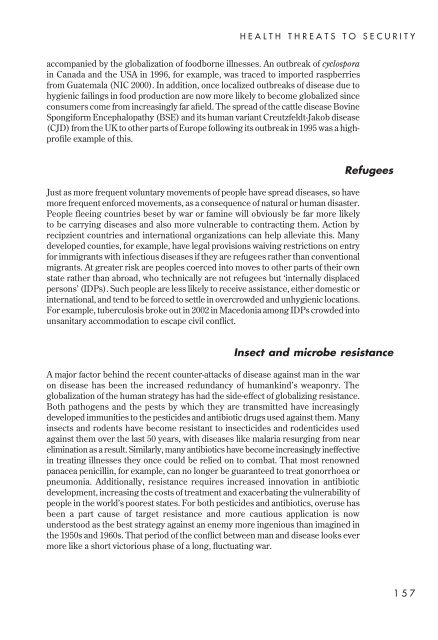Understanding global security - Peter Hough
Understanding global security - Peter Hough
Understanding global security - Peter Hough
Create successful ePaper yourself
Turn your PDF publications into a flip-book with our unique Google optimized e-Paper software.
HEALTH THREATS TO SECURITY<br />
accompanied by the <strong>global</strong>ization of foodborne illnesses. An outbreak of cyclospora<br />
in Canada and the USA in 1996, for example, was traced to imported raspberries<br />
from Guatemala (NIC 2000). In addition, once localized outbreaks of disease due to<br />
hygienic failings in food production are now more likely to become <strong>global</strong>ized since<br />
consumers come from increasingly far afield. The spread of the cattle disease Bovine<br />
Spongiform Encephalopathy (BSE) and its human variant Creutzfeldt-Jakob disease<br />
(CJD) from the UK to other parts of Europe following its outbreak in 1995 was a highprofile<br />
example of this.<br />
Just as more frequent voluntary movements of people have spread diseases, so have<br />
more frequent enforced movements, as a consequence of natural or human disaster.<br />
People fleeing countries beset by war or famine will obviously be far more likely<br />
to be carrying diseases and also more vulnerable to contracting them. Action by<br />
recipzient countries and international organizations can help alleviate this. Many<br />
developed counties, for example, have legal provisions waiving restrictions on entry<br />
for immigrants with infectious diseases if they are refugees rather than conventional<br />
migrants. At greater risk are peoples coerced into moves to other parts of their own<br />
state rather than abroad, who technically are not refugees but ‘internally displaced<br />
persons’ (IDPs). Such people are less likely to receive assistance, either domestic or<br />
international, and tend to be forced to settle in overcrowded and unhygienic locations.<br />
For example, tuberculosis broke out in 2002 in Macedonia among IDPs crowded into<br />
unsanitary accommodation to escape civil conflict.<br />
Refugees<br />
Insect and microbe resistance<br />
A major factor behind the recent counter-attacks of disease against man in the war<br />
on disease has been the increased redundancy of humankind’s weaponry. The<br />
<strong>global</strong>ization of the human strategy has had the side-effect of <strong>global</strong>izing resistance.<br />
Both pathogens and the pests by which they are transmitted have increasingly<br />
developed immunities to the pesticides and antibiotic drugs used against them. Many<br />
insects and rodents have become resistant to insecticides and rodenticides used<br />
against them over the last 50 years, with diseases like malaria resurging from near<br />
elimination as a result. Similarly, many antibiotics have become increasingly ineffective<br />
in treating illnesses they once could be relied on to combat. That most renowned<br />
panacea penicillin, for example, can no longer be guaranteed to treat gonorrhoea or<br />
pneumonia. Additionally, resistance requires increased innovation in antibiotic<br />
development, increasing the costs of treatment and exacerbating the vulnerability of<br />
people in the world’s poorest states. For both pesticides and antibiotics, overuse has<br />
been a part cause of target resistance and more cautious application is now<br />
understood as the best strategy against an enemy more ingenious than imagined in<br />
the 1950s and 1960s. That period of the conflict between man and disease looks ever<br />
more like a short victorious phase of a long, fluctuating war.<br />
157
















